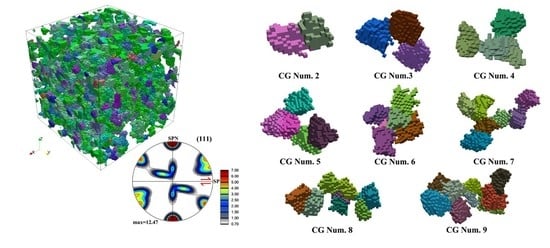Polycrystal Simulation of Texture-Induced Grain Coarsening during Severe Plastic Deformation
Abstract
:1. Introduction
2. The Simulation Scheme
2.1. Generation of a 3D Polycrystal Structure Using Cellular Automaton
2.2. Simulation Procedure
2.3. Microstructure Analysis
3. Simulation Results
3.1. Effect of Topology and Number of Voxel Division
3.2. Texture-Induced Grain Coarsening in 3D Polycrystals with Random Initial Texture
3.3. Cube-Type Initial Texture
3.4. Shear Texture
4. Discussion
5. Conclusions
- The texture-induced grain size coarsening effect can happen to a large volume fraction of grains of a polycrystal; up to ~40% during a shear strain of about 4.
- The coalescing volume depends on the initial texture. Among the three kinds of initial textures considered, it was the most relevant for shear textures (~40%), followed by the random case (~30%) and was the smallest for cube-type initial texture (~20%).
- The coalescence can be continued by splitting of the grains that coalesced together, which is an effect of the convergent/divergent nature of the rotation field around the ideal orientations in orientation space, typical for simple shear deformation.
- The coalescence frequency is about 4 times larger in 3D polycrystals compared to modelling in 2D.
Author Contributions
Funding
Acknowledgments
Conflicts of Interest
Appendix A
Taylor Polycrystal Plasticity Modeling
References
- Estrin, Y.; Vinogradov, A. Extreme grain refinement by severe plastic deformation: A wealth of challenging science. Acta Mater. 2013, 61, 782–817. [Google Scholar] [CrossRef]
- Toth, L.S.; Gu, C. Ultrafine-grain metals by severe plastic deformation. Mater. Charact. 2014, 92, 1–14. [Google Scholar] [CrossRef]
- Iwahashi, Y.; Horita, Z.; Nemoto, M.; Langdon, T.G. The process of grain refinement in equal-channel angular pressing. Acta Mater. 1998, 46, 3317–3331. [Google Scholar] [CrossRef]
- Valiev, R.Z.; Langdon, T.G. Principles of equal-channel angular pressing as a processing tool for grain refinement. Prog. Mater. Sci. 2006, 51, 881–981. [Google Scholar] [CrossRef]
- Iwahashi, Y.; Horita, Z.; Nemoto, M.; Langdon, T.G. An investigation of microstructural evolution during equal-channel angular pressing. Acta Mater. 1997, 45, 4733–4741. [Google Scholar] [CrossRef]
- Edalati, K.; Horita, Z. A review on high-pressure torsion (HPT) from 1935 to 1988. Mater. Sci. Eng. A 2016, 652, 325–352. [Google Scholar] [CrossRef]
- Zhilyaev, A.P.; Langdon, T.G. Using high-pressure torsion for metal processing: Fundamentals and applications. Prog. Mater. Sci. 2008, 53, 893–979. [Google Scholar] [CrossRef]
- Saito, Y.; Utsunomiya, H.; Tsuji, N.; Sakai, T. Novel ultra-high straining process for bulk materials—Development of the accumulative roll-bonding (ARB) process. Acta Mater. 1999, 47, 579–583. [Google Scholar] [CrossRef]
- Wang, C.; Li, F.; Wang, L.; Qiao, H. Review on modified and novel techniques of severe plastic deformation. Sci. China Technol. Sci. 2012, 55, 2377–2390. [Google Scholar] [CrossRef]
- Cao, Y.; Ni, S.; Liao, X.; Song, M.; Zhu, Y. Structural evolutions of metallic materials processed by severe plastic deformation. Mater. Sci. Eng. R Rep. 2018, 133, 1–59. [Google Scholar] [CrossRef]
- Tóth, L.S.; Estrin, Y.; Lapovok, R.; Gu, C. A model of grain fragmentation based on lattice curvature. Acta Mater. 2010, 58, 1782–1794. [Google Scholar] [CrossRef]
- Frydrych, K.; Kowalczyk-Gajewska, K. A three-scale crystal plasticity model accounting for grain refinement in fcc metals subjected to severe plastic deformations. Mater. Sci. Eng. A 2016, 658, 490–502. [Google Scholar] [CrossRef]
- Kobaissy, A.H.; Ayoub, G.; Toth, L.S.; Mustapha, S.; Shehadeh, M. Continuum dislocation dynamics-based grain fragmentation modeling. Int. J. Plast. 2019, 114, 252–271. [Google Scholar] [CrossRef]
- Frydrych, K. Simulations of grain refinement in various steels using the three-scale crystal plasticity model. Metall. Mater. Trans. A 2019, 50, 4913–4919. [Google Scholar] [CrossRef] [Green Version]
- Vinogradov, A.; Estrin, Y. Analytical and numerical approaches to modelling severe plastic deformation. Prog. Mater. Sci. 2018, 95, 172–242. [Google Scholar] [CrossRef]
- Gu, C.F.; Toth, L.S.; Rusz, S.; Bova, M. Texture induced grain coarsening in severe plastic deformed low carbon steel. Scr. Mater. 2014, 86, 36–39. [Google Scholar] [CrossRef]
- Pippan, R.; Scheriau, S.; Taylor, A.; Hafok, M.; Hohenwarter, A.; Bachmaier, A. Saturation of Fragmentation During Severe Plastic Deformation. Annu. Rev. Mater. Res. 2010, 40, 319–343. [Google Scholar] [CrossRef]
- Pougis, A.; Toth, L.S.; Fundenberger, J.J.; Borbely, A. Extension of the Derby relation to metals severely deformed to their steady-state ultrafine-grain size. Scr. Mater. 2014, 72–73, 59–62. [Google Scholar] [CrossRef]
- Kawasaki, M.; Horita, Z.; Langdon, T.G. Microstructural evolution in high purity aluminum processed by ECAP. Mater. Sci. Eng. A 2009, 524, 143–150. [Google Scholar] [CrossRef]
- Sakai, T.; Belyakov, A.; Kaibyshev, R.; Miura, H.; Jonas, J.J. Dynamic and post-dynamic recrystallization under hot, cold and severe plastic deformation conditions. Prog. Mater. Sci. 2014, 60, 130–207. [Google Scholar] [CrossRef] [Green Version]
- Janssens, K.G.F. An introductory review of cellular automata modeling of moving grain boundaries in polycrystalline materials. Math. Comput. Simul. 2010, 80, 1361–1381. [Google Scholar] [CrossRef]
- Sieradzki, L.; Madej, L. A perceptive comparison of the cellular automata and Monte Carlo techniques in application to static recrystallization modeling in polycrystalline materials. Comput. Mater. Sci. 2013, 67, 156–173. [Google Scholar] [CrossRef]
- Zhang, K.S.; Wu, M.S.; Feng, R. Simulation of microplasticity-induced deformation in uniaxially strained ceramics by 3-D Voronoi polycrystal modeling. Int. J. Plast. 2005, 21, 801–834. [Google Scholar] [CrossRef]
- Bargmann, S.; Klusemann, B.; Markmann, J.; Schnabel, J.E.; Schneider, K.; Soyarslan, C.; Wilmers, J. Generation of 3D representative volume elements for heterogeneous materials: A review. Prog. Mater. Sci. 2018, 96, 322–384. [Google Scholar] [CrossRef]
- Beausir, B.; Fundenberger, J.-J. Analysis Tools for Electron and X-ray Diffraction; ATEX-Software; Université de Lorraine-Metz: Metz, France, 2017. [Google Scholar]
- Toth, L.S.; Houtte, P.V. Discretization techniques for orientation distribution functions. Textures Microstruct. 1992, 19, 229–244. [Google Scholar] [CrossRef]
- Toth, L.S.; Gilormini, P.; Jonas, J.J. Effect of rate sensitivity on the stability of torsion textures. Acta Metall. 1988, 36, 3077–3091. [Google Scholar] [CrossRef]
- Groeber, M.A.; Jackson, M.A. DREAM.3D: A digital representation environment for the analysis of microstructure in 3D. Integr. Mater. Manuf. Innov. 2014, 3, 56–72. [Google Scholar] [CrossRef] [Green Version]
- Ayachit, U. The Paraview Guide: A Parallel Visualization Application; Kitware: Clifton Park, NY, USA, 2015. [Google Scholar]
- Beyerlein, I.J.; Tóth, L.S. Texture evolution in equal-channel angular extrusion. Prog. Mater. Sci. 2009, 54, 427–510. [Google Scholar] [CrossRef]
- Tóth, L.S.; Neale, K.W.; Jonas, J.J. Stress response and persistence characteristics of the ideal orientations of shear textures. Acta Metall. 1989, 37, 2197–2210. [Google Scholar] [CrossRef]
- Vu, V.Q.; Toth, L.S.; Beygelzimer, Y.; Kulagin, R.; Kobaissy, A.H. Modeling of crystallographic texture in plastic flow machining. Adv. Eng. Mater. 2019, 22, 1900661. [Google Scholar] [CrossRef]
- Zhou, Y.; Tóth, L.S.; Neale, K.W. On the stability of the ideal orientations of rolling textures for F.C.C. polycrystals. Acta Metall. Mater. 1992, 40, 3179–3193. [Google Scholar] [CrossRef]
- Raabe, D.; Zhao, Z.; Park, S.J.; Roters, F. Theory of orientation gradients in plastically strained crystals. Acta Mater. 2002, 50, 421–440. [Google Scholar] [CrossRef]
- Barnett, M.R.; Montheillet, F. The generation of new high-angle boundaries in aluminium during hot torsion. Acta Mater. 2002, 50, 2285–2296. [Google Scholar] [CrossRef]
- Mackenzie, J.K. Second paper on statistics associated with the random disorientation of cubes. Biometrika 1958, 45, 229–240. [Google Scholar] [CrossRef]
- Belyakov, A.; Sakai, T.; Miura, H.; Tsuzaki, K. Grain refinement in copper under large strain deformation. Philos. Mag. A 2001, 81, 2629–2643. [Google Scholar] [CrossRef]
- Baik, S.C.; Estrin, Y.; Kim, H.S.; Hellmig, R.J. Dislocation density-based modeling of deformation behavior of aluminium under equal channel angular pressing. Mater. Sci. Eng. A 2003, 351, 86–97. [Google Scholar] [CrossRef]

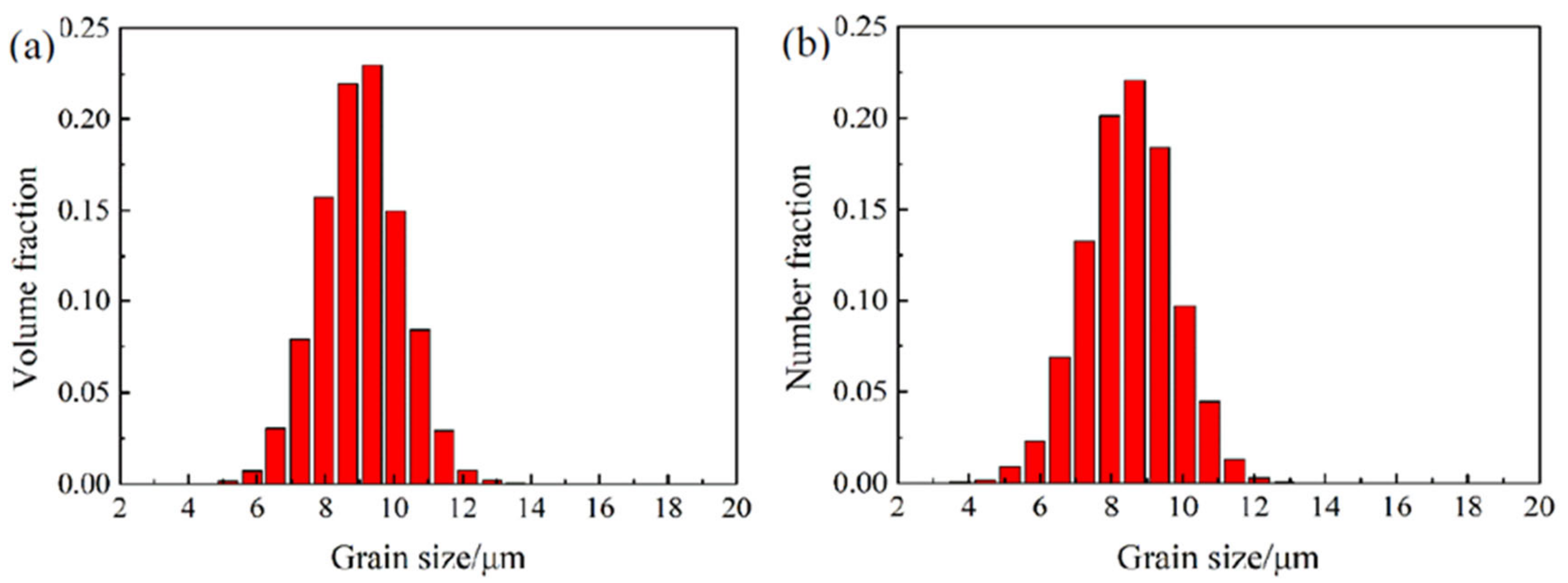

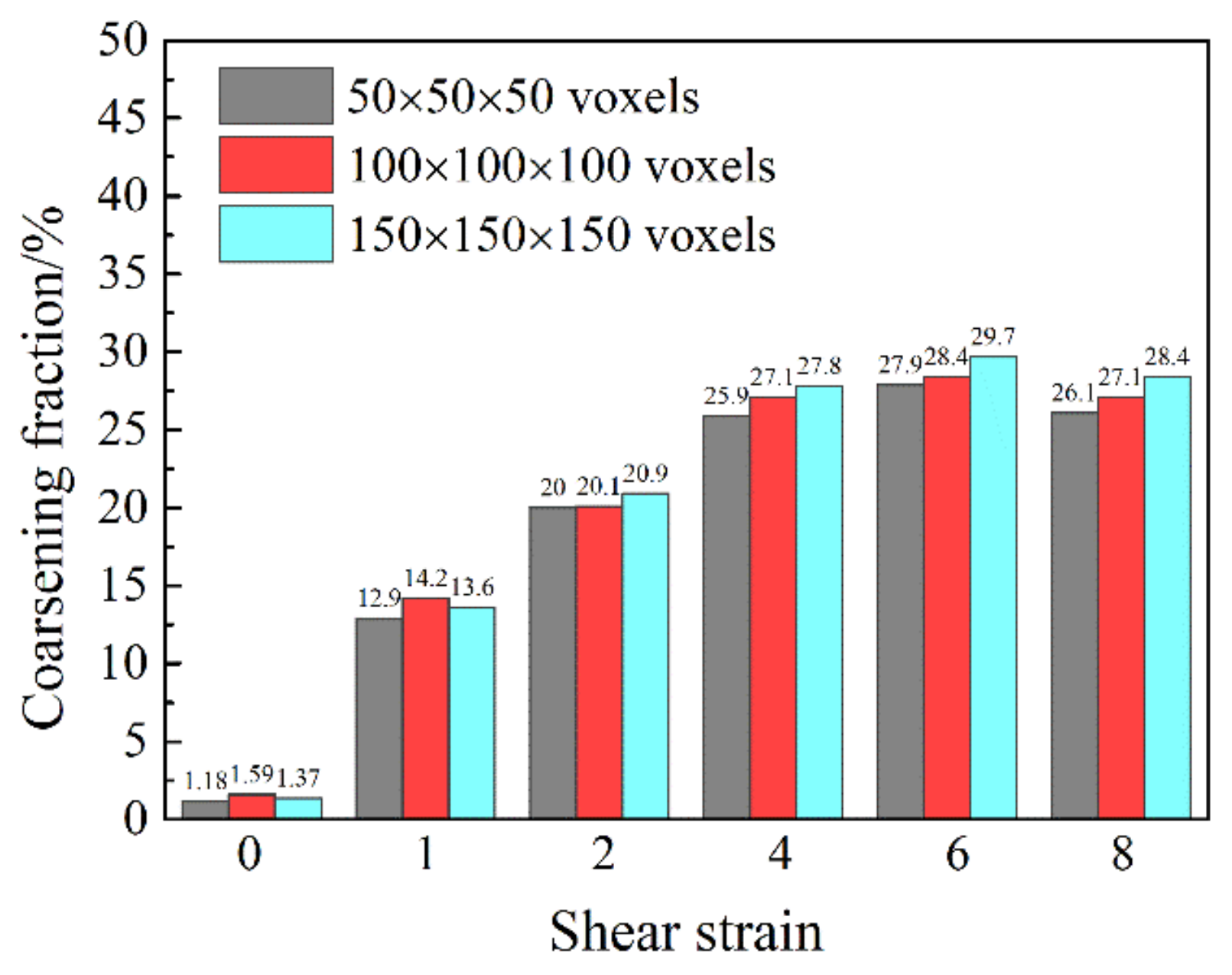

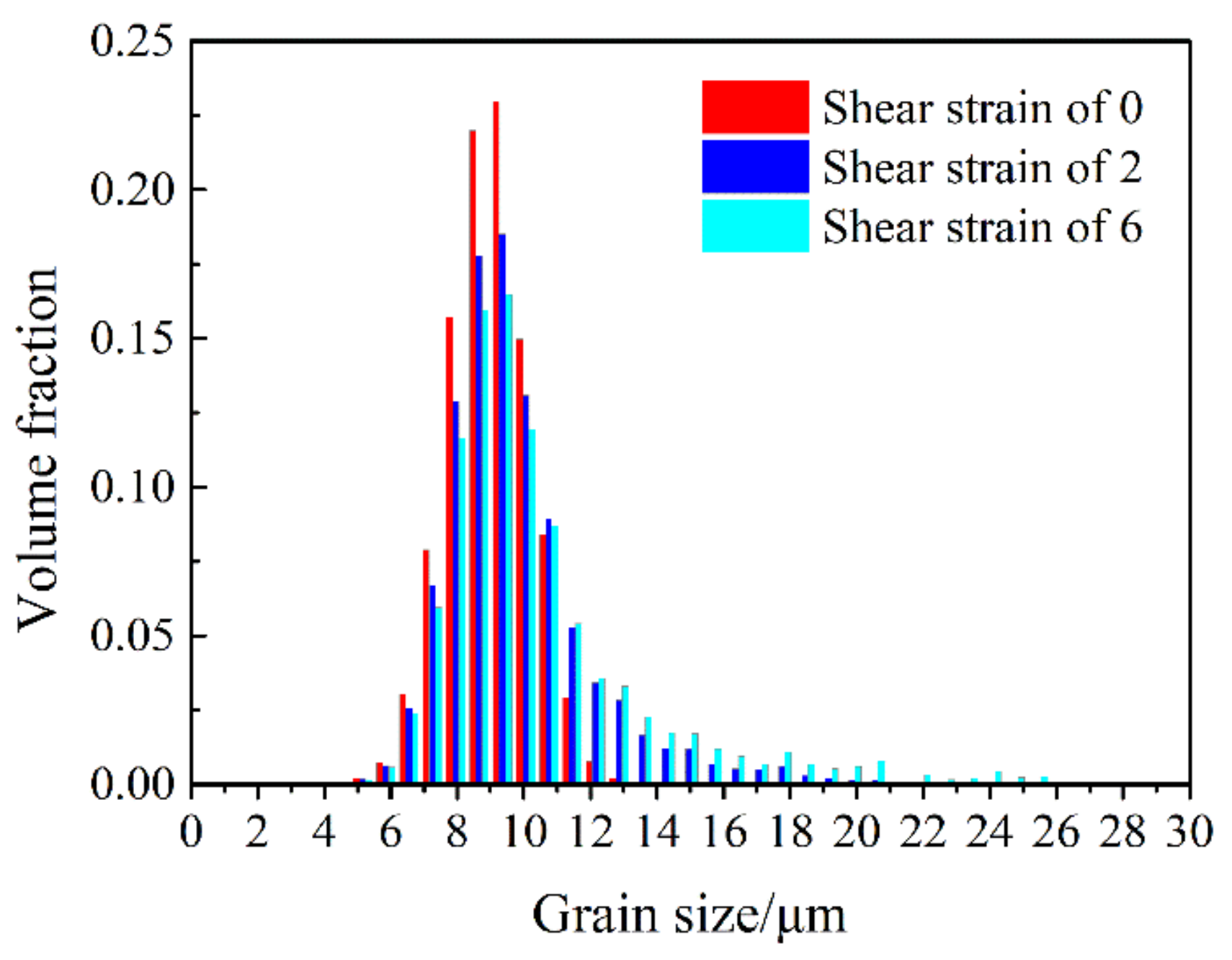
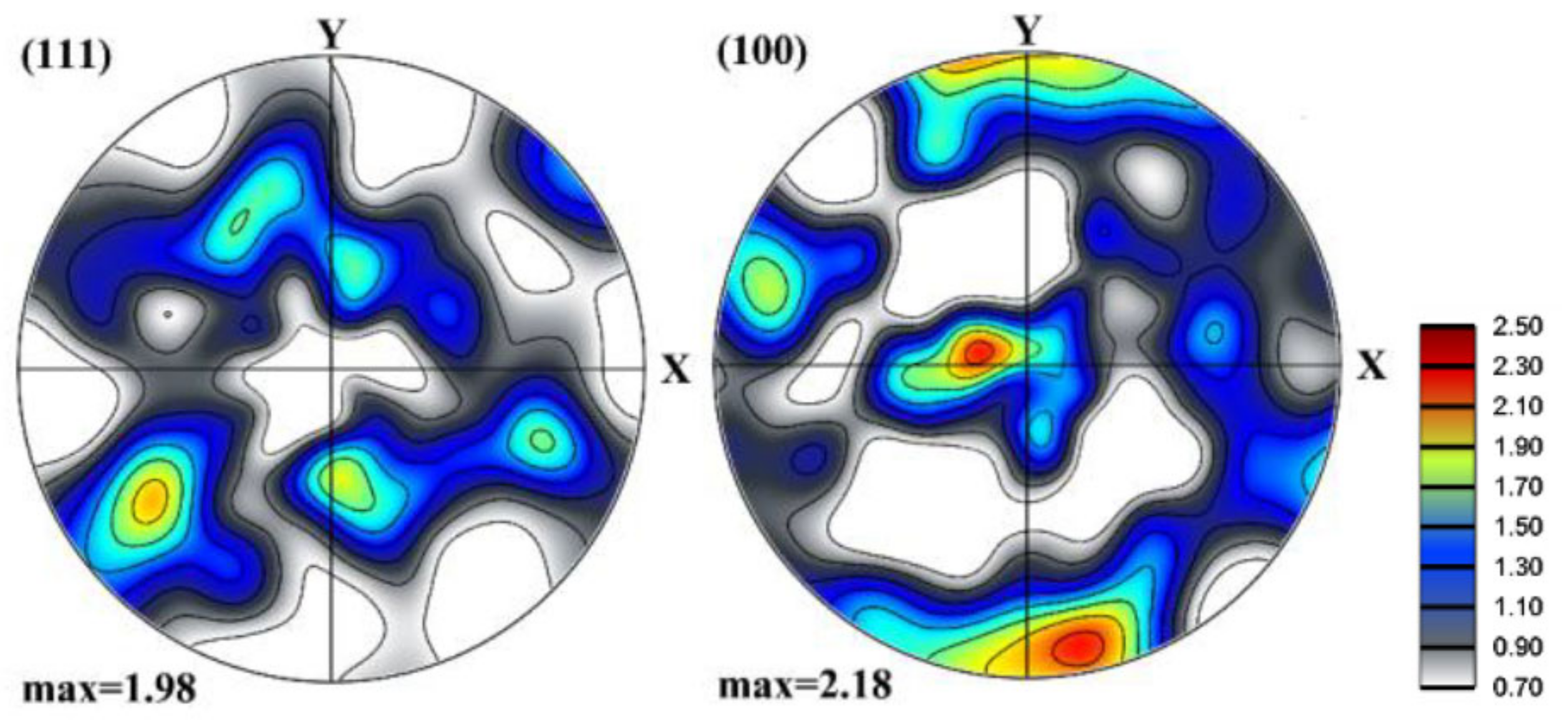
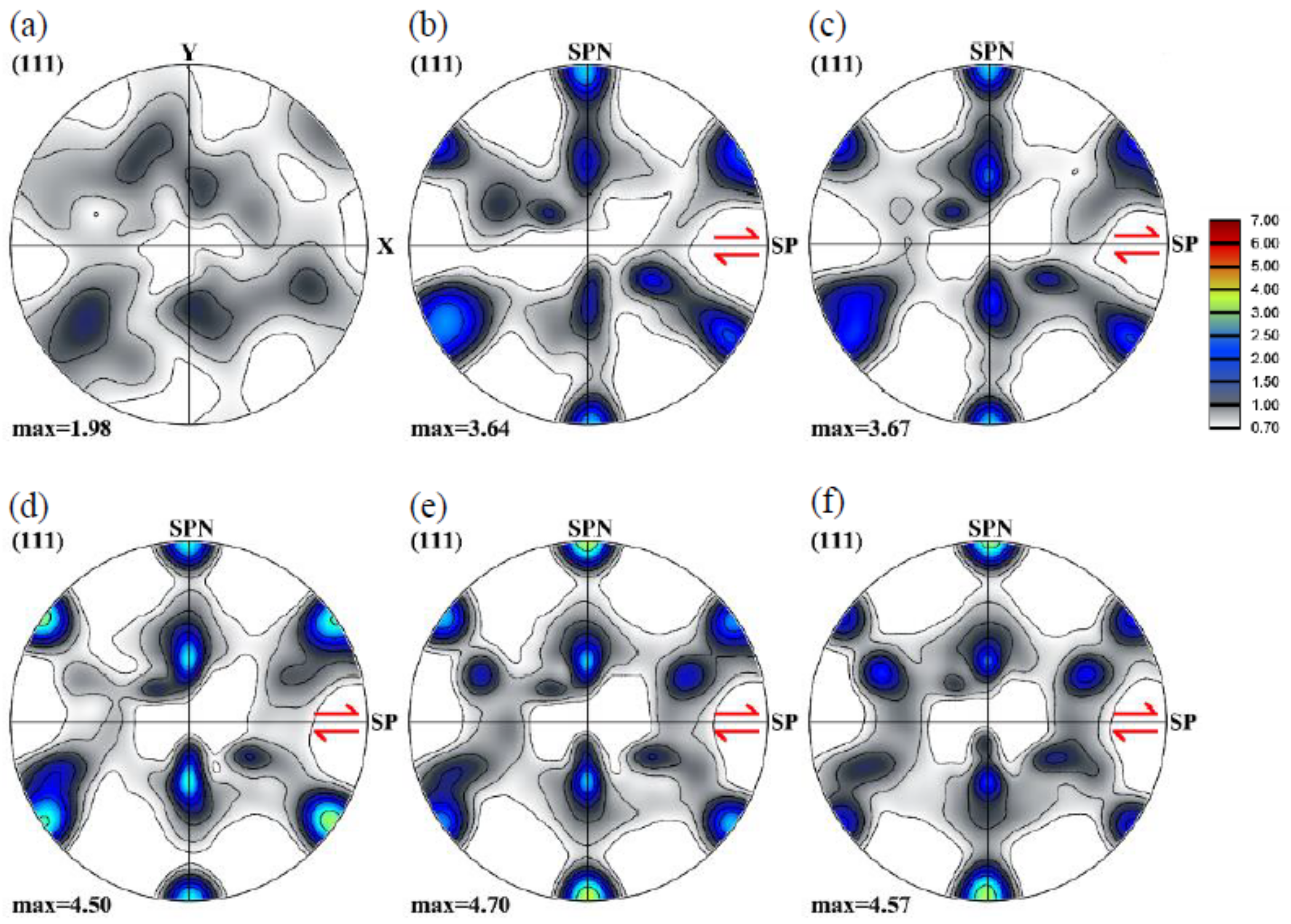
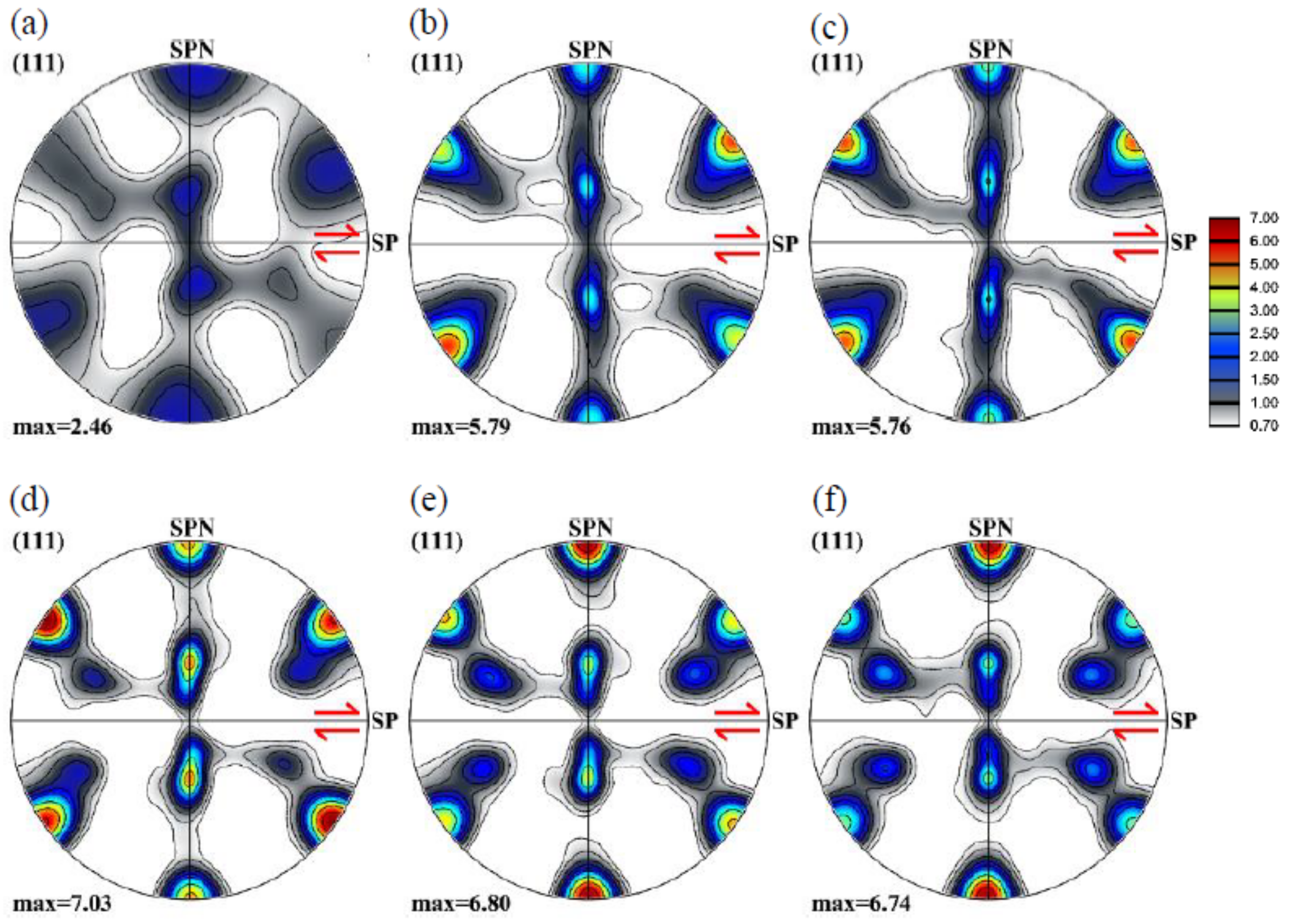
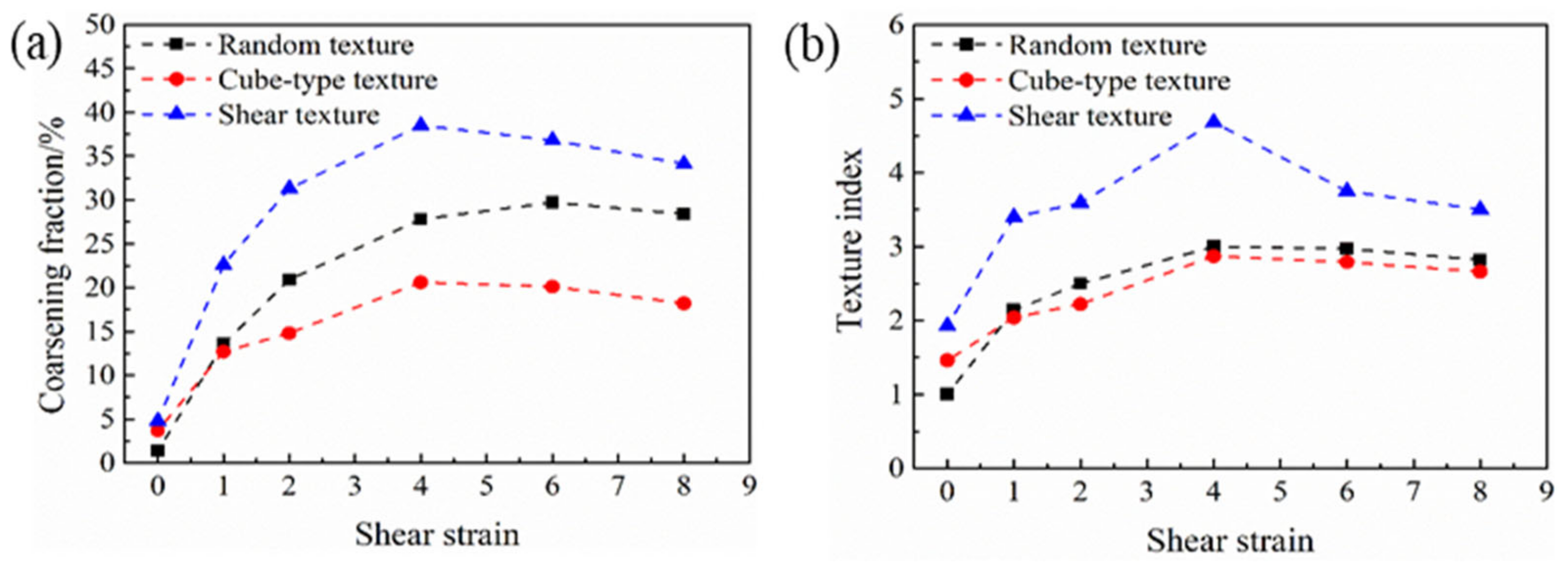

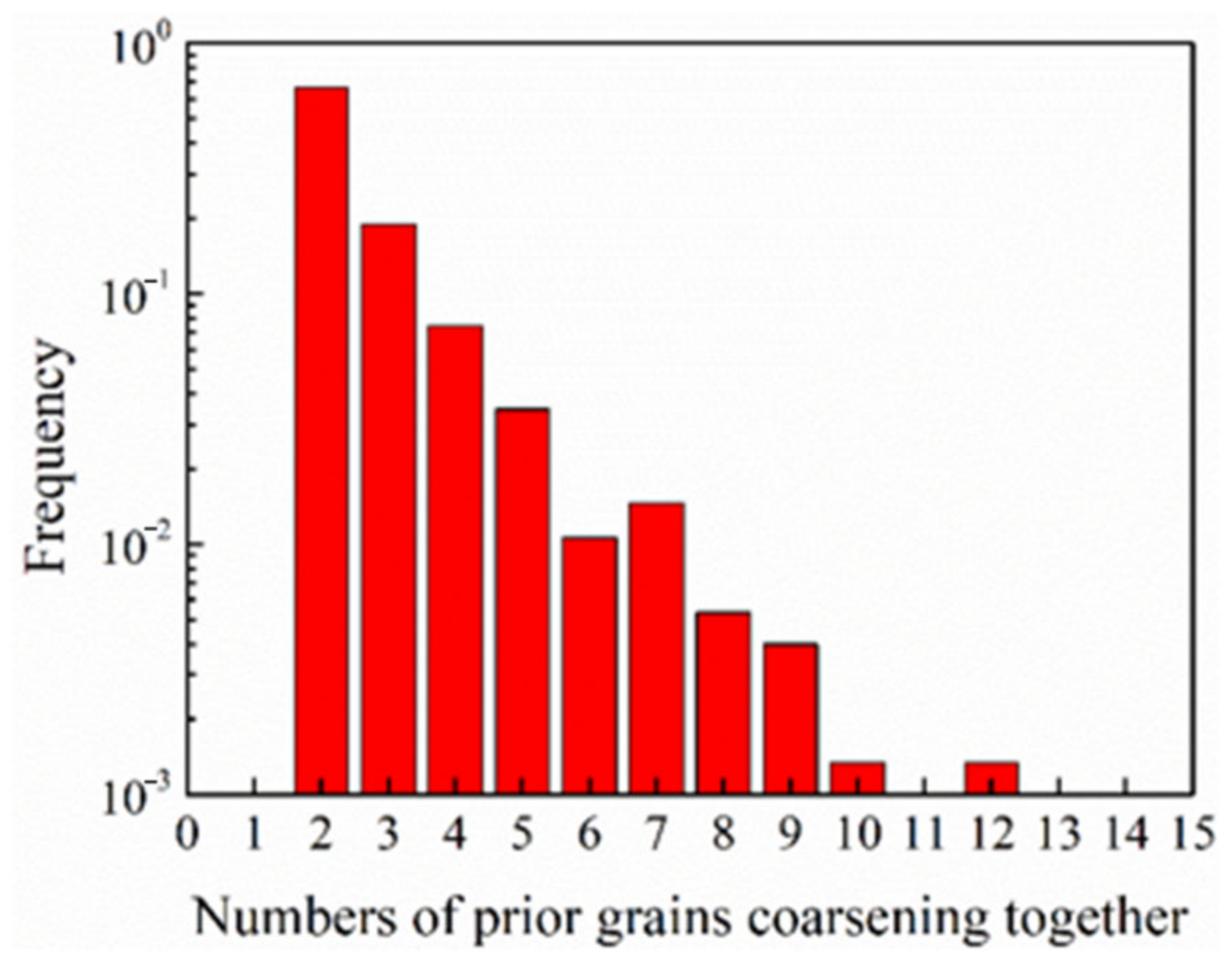
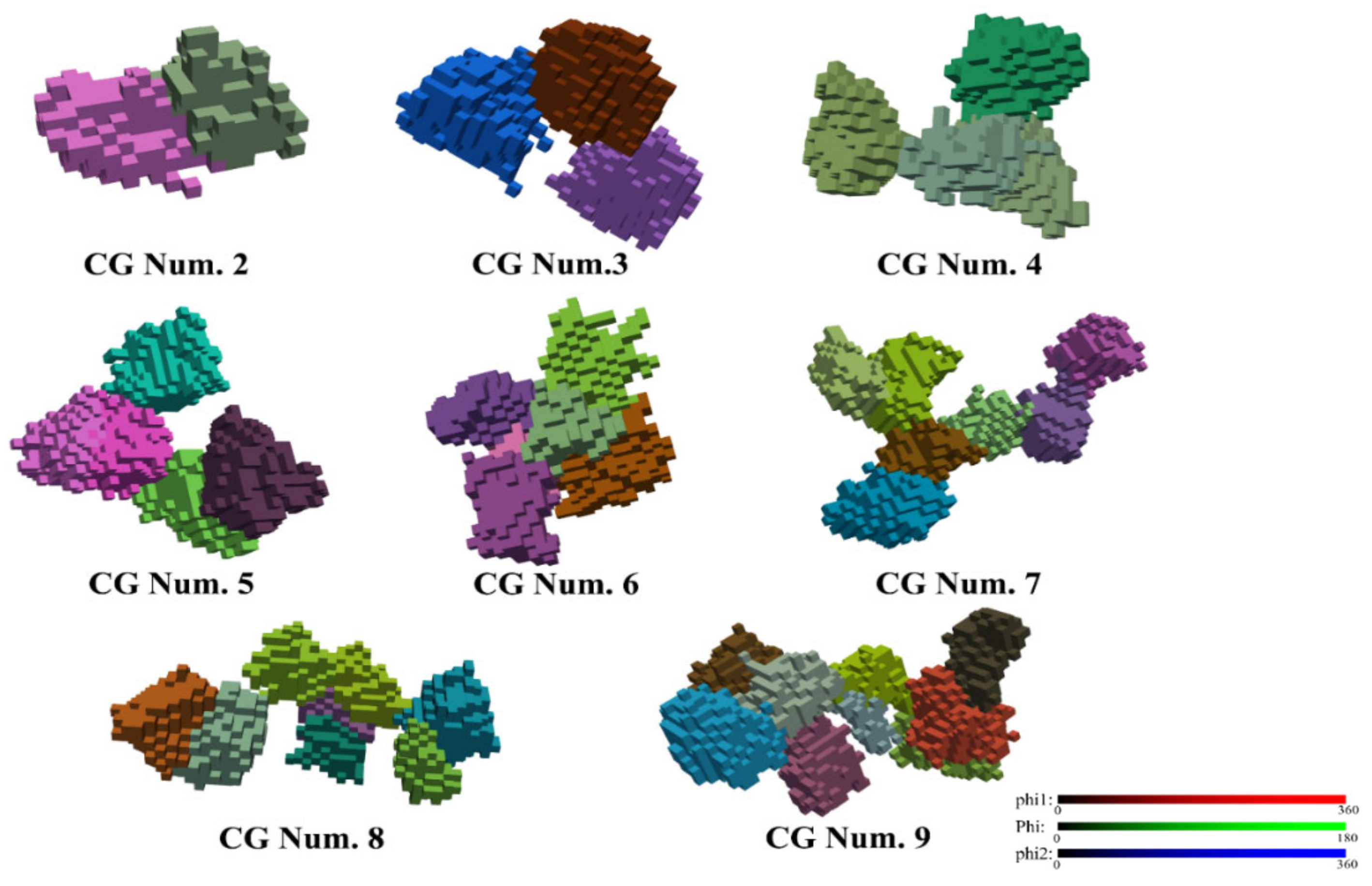
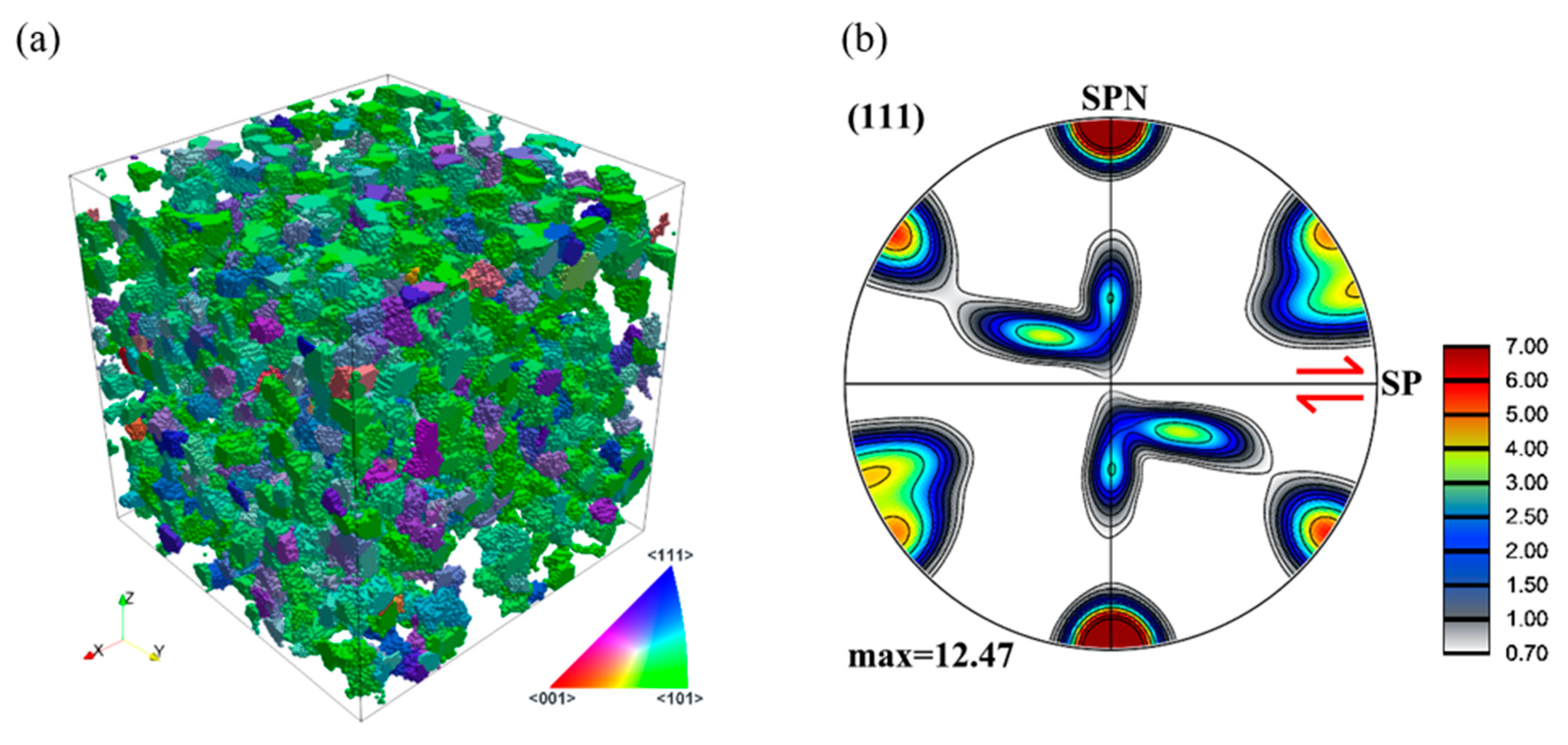
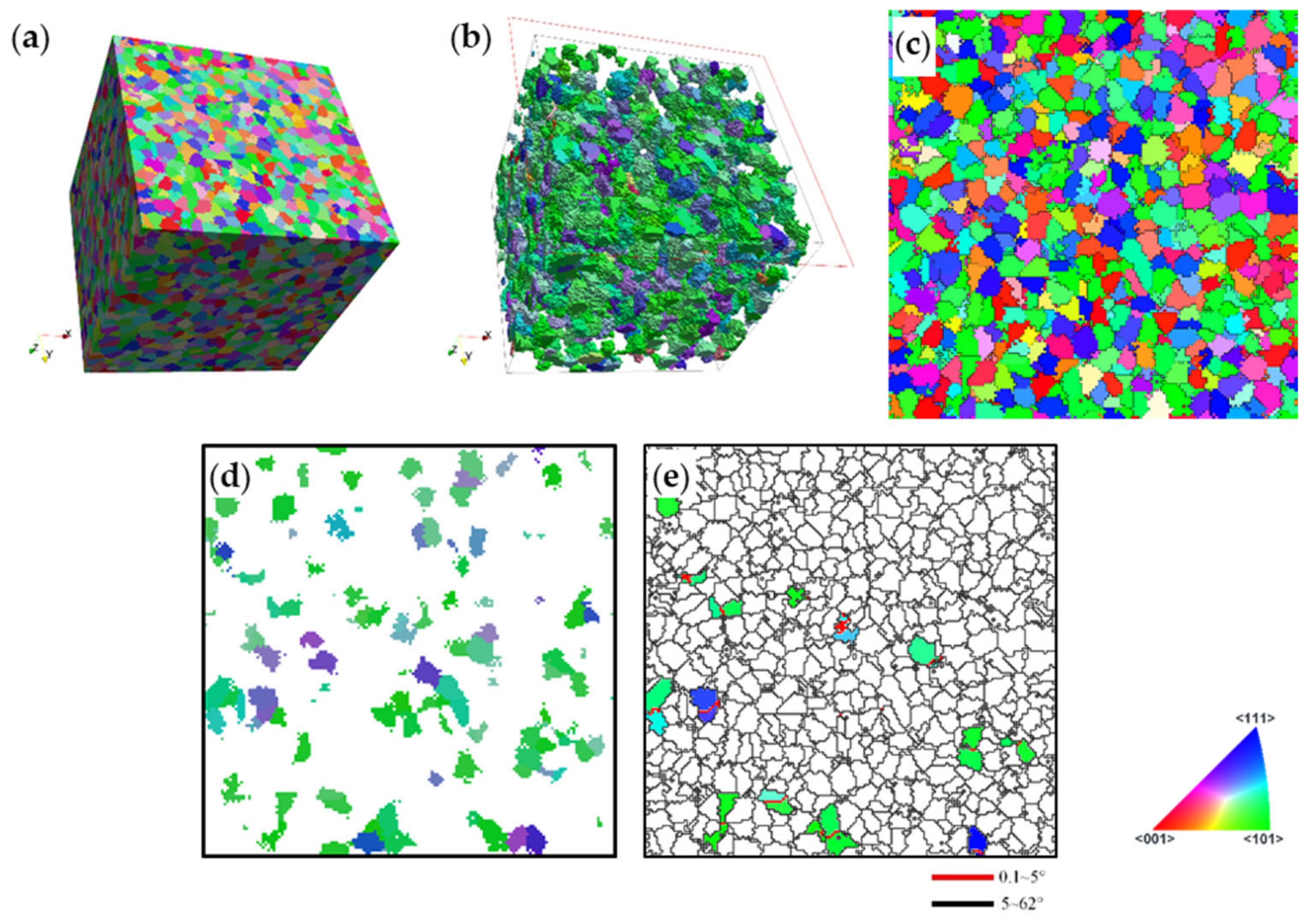
| Shear Strain | 0 | 1 | 2 | 4 | 6 | 8 |
|---|---|---|---|---|---|---|
| Grain number | 9934 | 9250 | 8763 | 8238 | 8095 | 8201 |
| Average grain size (number-weighted)/μm | 8.48 | 8.62 | 8.72 | 8.81 | 8.84 | 8.82 |
| Average grain size (volume-weighted)/μm | 9.00 | 9.38 | 9.76 | 10.27 | 10.45 | 10.38 |
| Number of new grains by coalescence | 64 | 555 | 754 | 897 | 937 | 926 |
| Number of coalescing initial grains | 130 | 1305 | 1991 | 2659 | 2842 | 2725 |
| Coalescing volume fraction | 1.4% | 13.6% | 20.9% | 27.8% | 29.7% | 28.4% |
| Shear Strain | 0 | 1 | 2 | 4 | 6 | 8 |
|---|---|---|---|---|---|---|
| Grain number | 9828 | 9320 | 9153 | 8706 | 8754 | 8914 |
| Average grain size (number-weighted)/μm | 8.50 | 8.60 | 8.63 | 8.70 | 8.70 | 8.68 |
| Average grain size (volume-weighted)/μm | 9.06 | 9.35 | 9.49 | 10.00 | 9.98 | 9.69 |
| Number of new grains by coalescence | 167 | 512 | 554 | 663 | 666 | 651 |
| Number of coalescing initial grains | 339 | 1192 | 1401 | 1957 | 1912 | 1737 |
| Coalescing volume fraction | 3.7% | 12.7% | 14.8% | 20.6% | 20.1% | 18.2% |
| Shear Strain | 0 | 1 | 2 | 4 | 6 | 8 |
|---|---|---|---|---|---|---|
| Grain number | 9776 | 8531 | 7784 | 7132 | 7361 | 7630 |
| Average grain size (number-weighted)/μm | 8.51 | 8.72 | 8.80 | 8.89 | 8.88 | 8.90 |
| Average grain size (volume-weighted)/μm | 9.08 | 10.30 | 12.40 | 14.19 | 13.80 | 11.50 |
| Number of new grains by coalescence | 218 | 692 | 775 | 848 | 878 | 919 |
| Number of coalescing initial grains | 442 | 2161 | 2991 | 3716 | 3517 | 3289 |
| Coalescing volume fraction | 4.8% | 22.6% | 31.3% | 38.5% | 36.8% | 34.1% |
Publisher’s Note: MDPI stays neutral with regard to jurisdictional claims in published maps and institutional affiliations. |
© 2020 by the authors. Licensee MDPI, Basel, Switzerland. This article is an open access article distributed under the terms and conditions of the Creative Commons Attribution (CC BY) license (http://creativecommons.org/licenses/by/4.0/).
Share and Cite
Zhang, C.; Toth, L.S. Polycrystal Simulation of Texture-Induced Grain Coarsening during Severe Plastic Deformation. Materials 2020, 13, 5834. https://doi.org/10.3390/ma13245834
Zhang C, Toth LS. Polycrystal Simulation of Texture-Induced Grain Coarsening during Severe Plastic Deformation. Materials. 2020; 13(24):5834. https://doi.org/10.3390/ma13245834
Chicago/Turabian StyleZhang, Chi, and Laszlo S. Toth. 2020. "Polycrystal Simulation of Texture-Induced Grain Coarsening during Severe Plastic Deformation" Materials 13, no. 24: 5834. https://doi.org/10.3390/ma13245834
APA StyleZhang, C., & Toth, L. S. (2020). Polycrystal Simulation of Texture-Induced Grain Coarsening during Severe Plastic Deformation. Materials, 13(24), 5834. https://doi.org/10.3390/ma13245834





